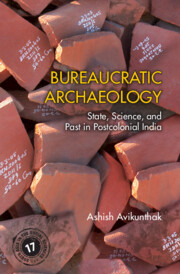Book contents
- Frontmatter
- Dedication
- Contents
- List of Figures
- Preface
- Acknowledgments
- Note on Transliteration
- List of Abbreviations
- 1 Anthropology of Archaeology
- 2 The Making of the Indus–Saraswati Civilization
- 3 Bureaucratic Hierarchy in the ASI
- 4 Spatial Formation of the Archaeological Field
- 5 Epistemological Formation of the Archaeological Site
- 6 Theory of Archaeological Excavation
- 7 Making of the Archaeological Artifact
- 8 Performance of Archaeological Representations
- 9 The Absent Excavation Reports
- Conclusion
- Bibliography
- Index
5 - Epistemological Formation of the Archaeological Site
Published online by Cambridge University Press: 20 August 2021
- Frontmatter
- Dedication
- Contents
- List of Figures
- Preface
- Acknowledgments
- Note on Transliteration
- List of Abbreviations
- 1 Anthropology of Archaeology
- 2 The Making of the Indus–Saraswati Civilization
- 3 Bureaucratic Hierarchy in the ASI
- 4 Spatial Formation of the Archaeological Field
- 5 Epistemological Formation of the Archaeological Site
- 6 Theory of Archaeological Excavation
- 7 Making of the Archaeological Artifact
- 8 Performance of Archaeological Representations
- 9 The Absent Excavation Reports
- Conclusion
- Bibliography
- Index
Summary
My daily routine at Dholavira began with a quick early morning breakfast. Soon after, I joined the staff and students as they scurried to the excavation site. I usually accompanied one of the assistant archaeologists (AAs) and sometimes the director of the site during their daily “inspection round.” There were between two and four AAs at Dholavira at all times. Some of them were from the New Delhi headquarters; others were on deputation from other Excavation Branches (Ex. Brs.) or Circles. By the time we arrived at the excavation trenches, all the students and ex-students in charge of the quadrants were at their respective locations, planning the day's work. The laborers were always the first to reach the site. They began the day by dusting the trench floor or clearing the dirt, preparing for the next “dig.” Dholavira was a monumental site, so the inspection took up the entire day as we meandered from one trench to another. We would start by climbing the fortification wall into the citadel, trotting through the Middle Town into the Lower Town, descending into the various reservoirs, and reaching the burial grounds at the perimeter of this expansive Harappan metropolis. As a ritual, we would return to the citadel and sit atop the highest point of the site—at the edge of the colossal fortification wall. Perched atop the fortification wall, sitting on ancient limestone blocks carved more than three millennia ago, we could see the entire ancient cityscape, across the Rann—its surreal snow-white salt-water marsh disappearing into the edge of the earth. The paleness of the still water was transformed into a golden expanse in the glimmering rays of the setting sun.
Sharp at 5 p.m., the chowkidar struck the makeshift bell made of a cast-iron cylinder, signaling the end of the day's work. He was an elderly, weary man with a luxurious salt-and-pepper moustache, who wore a colorful turban, and typically donned a terry-cot bush-shirt and a pale white dhoti. Supporting his frail gait with a wooden shaft, he walked every day from the campsite to the citadel, from where everyone could see and hear him. Soon, a small army of fatigued laborers arose rapidly from the trenches.
- Type
- Chapter
- Information
- Bureaucratic ArchaeologyState, Science, and Past in Postcolonial India, pp. 128 - 152Publisher: Cambridge University PressPrint publication year: 2021

